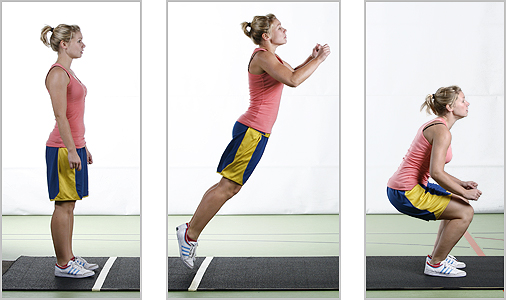Standing Long Jump (SLJ)
Back to overview
1. Test objective
Determination of the explosive strength of the lower extremities.
2. Description of the task

In the standing long jump, the test person is to jump as far as possible with a double-leg takeoff. The test person stands in a parallel stance with bent legs at the jump line. Swinging with the arms is allowed. The jump is done with both legs and the landing on both feet. During the landing, the hand must not reach backwards. The test person has two attempts. In case of two invalid attempts, the test person gets a maximum of three more attempts. If the test person has five failed attempts, the test is stopped.
3. Test materials
| 3.1 | Space requirement: approx. 2 m x 4 m |
| 3.2 | Time and person requirements: a test administrator can test 2 jumps of a test person within 2 minutes |
| 3.3 | Equipment and material: measuring tape, adhesive tape, tartan granulate mat (80 cm x 300 cm), L-rail |
4. Test setup
The test is performed on a tartan granulate mat to standardize the take-off conditions. The mat is attached to the floor in a non-slip manner. A take-off line is attached to the mat and a measuring tape is attached along the edge of the mat.
5. Measurement recording
The distance from the take-off line to the heel of the rear foot is measured during landing. For a better reading of the measured value on the measuring tape, an L-rail or a rod which can be placed against the heel is suitable. The measurement is taken to an accuracy of 0.1 centimeter. The better distance from the two tests is scored.
Standard values
Numerous studies are available with information on mean values and standard deviations (see Beck & Bös, 1995, p. 118 ff). Comparative values for children and adults are also available for the standing long jump in the test literature (Fetz & Kornexl, 1993; Grosser & Starischka, 1981). Normal values for children and adolescents from 6-18 are published in the DMT Manual (Bös et al. 2009).
6. Test instruction
This test is about jumping as far as possible from a standing position. Stand on the line. Now use your arms to gain momentum and jump forward with both legs as far as you can. When you land, make sure that you don't fall backwards, grab or step backwards after the jump. You have 2 attempts.
7. Special notes
The exercise should be performed with sports shoes. Falling forward is allowed as long as the heel stays on the landing position.
Sources of error
Stepping over the starting line or jumping with one leg.
Falling backwards or reaching backwards on landing.
Heel of the back leg moving away from the landing position.
8. Sources
Beck, J. & Bös, K. (1995). Normwerte motorischer Leistungsfähigkeit: Köln: Strauss.
Bös, K., Schlenker, L., Büsch, D., Lämmle, L., Müller, H., Oberger, J., Seidel, I. & Tittlbach, S. (2009). Deutscher Motorik Test 6-18. Hamburg: Czwalina.
Council of Europe (Ed.). (1983). Testing physical fitness (Eurofit). Provisional Handbook. Straßbourg: Author.
Fetz, F., & Kornexl, E. (1993). Sportmotorische Tests: praktische Anleitung zu sportmotorischen Tests in Schule und Verein. Wien: ÖBV, Pädag. Verlag.
Grosser, M. & Starischka, S. (1986). Konditionstests: Theorie u. Praxis aller Sportarten. München: BLV-Verlagsgesellschaft.
